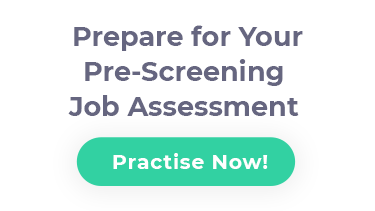Barclays Assessment Tests, Recruitment Process & Interviews Online Preparation – 2025

About Barclays
Barclays is a multinational bank based in London, England. It ranks as the fourth-largest bank in the United Kingdom and one of the largest in the world. They provide retail banking, investment banking, wealth management, credit cards, and other financial services to over 48 million customers ranging from individuals to large corporations in the UK and the world (Barclays International).
It often ranks as one of the top 100 businesses to work for in the UK for the following reasons:
- Private medical insurance
- Pension plan
- Severance pay
- Life and dental insurance
- A reasonable work-life balance
Barclays has over nearly 90,000 employees around the world, with almost half of them working in the UK. The excellent benefits, pay, and prestige of working for a top British bank mean the competition for a job at Barclays is fierce. They receive tens of thousands of applications each year from qualified candidates. The hiring process is meant to find the best employees possible and is challenging.
What Is the Recruitment Process at Barclays?
As mentioned previously, Barclays has a difficult hiring process. It involves a few interviews and one or more assessment tests at a minimum. Some positions require case studies and technical interviews that test your industry knowledge. But what makes the hiring process difficult are the high standards that Barclays has for hiring an applicant.
Online Application
Like most major corporations, the hiring process for Barclays starts by applying for a position on Barclays’ official job portal. Applicants must create a profile and upload their CV and cover letter and apply for open positions.
Barclays Online Assessment
Some applicants will have to take a series of psychometric tests before advancing to the interview stage of the hiring process. The tests an applicant takes depend entirely on the position – some positions (investment banking) require five or six assessment tests, while others only require one or two tests.
Barclays uses Cappfinity (CAPP) tests and SHL tests, so if you have taken their tests or practice tests, then you should have an idea of what to expect. Here are some of the tests that applicants might take:
- Situational Judgment Test (SJT) – This is a behavioural test that most applicants will have to take. It will present workplace scenarios and ask the applicant to select the best response from a list of options. This test does not have right or wrong answers per se, but Barclays wants to see certain responses more than others. Applicants should select the answers that best match the company values while causing as few problems as possible. It is important to note that the workplace scenarios presented will depend on the job. Investment bankers receive a different SJT than bank tellers.
- Numerical Reasoning Test – The numerical reasoning test will test the applicant’s ability to quickly and accurately read data from a variety of different data presentations, such as graphs, charts, and diagrams. The questions on this test are not particularly difficult, even for those that struggle with maths, if you review data presentations and know how to calculate percentages and ratios. The difficulty of this test stems from the fact that applicants have 30 minutes to answer 35 questions. It is almost necessary to take timed practice numerical reasoning practice tests to prepare for this test. This will teach you to balance speed with accuracy.
- Logical Reasoning Test – The logical reasoning test will test the applicant’s ability to identify patterns. Each question consists of a group of 2D or 3D shapes arranged in a particular way that changes over five frames – the changes could be in size, shape, and/or arrangement. The applicant must select the answer that best completes the pattern. This psychometric test can challenge some applicants because the patterns can be very abstract at times. This test is 25 minutes and has 24 questions. Applicants will have less than a minute (on average) to correctly determine the proper continuation for each pattern.
- Occupational Personality Test (SHL OPQ) – The occupational personality test is a personality test that will determine if the applicant’s personality fits the desirable personality of the position they applied for at Barclays. This test does have checks to detect deception, which means you should answer questions honestly and consistently. If the applicant’s personality does not match what Barclays wants, then the applicant will fail the test. Practice tests are available for this test and can help prepare applicants for the types of questions they will see on it, so they are certainly worth taking for that reason.
- Verbal Reasoning Test – The verbal reasoning test will test the applicant’s ability to quickly find relevant information from a few paragraphs of information. This test can often prove challenging for applicants as they will have 30 minutes to answer 25 questions. This time includes the time reading the paragraphs, so it is important to read quickly and accurately for this test. It is also important to note that this test is in English.
- Barclays Values and Mindset Assessment
- Barclays Experience Platform Assessment
Video Interview
If the applicant passes the difficult assessment tests, then they will receive an invite for a video interview. This is a pre-recorded video interview. A video recording of the interviewer asking a question is shown to the applicant, and the applicant then records themself answering the question.
A Barclays employee will watch the response videos and determine whether or not the applicant will advance to the next phase of the hiring process.
This is not a technical interview – the questions are all behavioural questions meant to determine if the applicant is a good fit for the company. It is important to have good posture and a neutral facial expression with a slight smile, as AI analysis is used to determine your emotional state during the video.
As for the questions, you should use the STAR method (Situation, task, action, response) when formulating your answer.
Barclays’ Assessment Centre
The final stage of the hiring process is an assessment centre held at Barclay’s main office in London. Applicants will do a group case study and have two interviews at the assessment centre.
- Case Study – In the case study interview, Barclays will send a file containing a case study similar to one that you may receive as a Barclays employee. The candidate must then turn the findings from the case study into a report or presentation and share that report or presentation during their interview. Barclays wants to see that you understand and relay important information from the case study. It is also a chance for the interviewers to see your presentation skills.
- Final Interview – The final interview will be done with one or more members of the team you will work with if Barclays offers you a job. This interview may contain some technical questions, but it is mostly a behavioural interview where the team can find out if you would fit well on the team.
How to Prepare for Barclays’ Assessment Tests?
Preparation for the assessment tests at Barclays should focus on two things:
- Time management – Finance is a fast-paced industry where mistakes can cost millions of dollars, so Barclays wants employees that can think fast with little to no errors. This is why their assessment tests have such short time limits. The best way to practise time management skills is to take timed practice tests similar to the ones that Barclays gives applicants. This will teach your brain to work quickly and learn to balance speed with accuracy – Barclays wants both, so you should strive for 100% on your tests within the allotted time.
- Having the knowledge to pick the correct answer – This mostly applies to the numerical reasoning test, which requires applicants to have some previous knowledge of reading data from different data sets and making quick mental maths calculations. Practice tests with answer explanations work best for this. Memorising the correct answer is not enough – you must understand why it is the correct answer.

